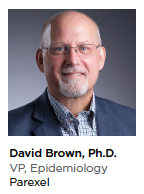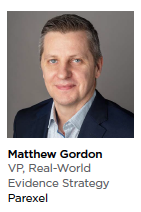 With so much attention being focused on real-world evidence (RWE) and real-world data (RWD), it would be easy to assume that this critical area of drug development is revolutionary. But, in fact, RWE has been around for decades and what the industry is currently experiencing is an evolution of processes founded in solid science and good clinical study practices to support regulatory, payer, and physician stakeholder decisions. That’s not to say there haven’t been some revolutionary forces at play to put patients at the heart of the RWE and RWD movement.
With so much attention being focused on real-world evidence (RWE) and real-world data (RWD), it would be easy to assume that this critical area of drug development is revolutionary. But, in fact, RWE has been around for decades and what the industry is currently experiencing is an evolution of processes founded in solid science and good clinical study practices to support regulatory, payer, and physician stakeholder decisions. That’s not to say there haven’t been some revolutionary forces at play to put patients at the heart of the RWE and RWD movement.
The power of RWE/RWD lies in its ability to describe how patients truly  respond to therapies, and how these therapies compare with one another, outside of the controlled environment of a clinical trial — as a way to best understand the true impact on patients’ health and outcomes. These insights allow companies to demonstrate the real value that their product brings relative to other treatments, and to ensure regulatory and prescribing decisions best reflect this value, says Matthew Gordon, VP, Real-World Evidence Strategy.
respond to therapies, and how these therapies compare with one another, outside of the controlled environment of a clinical trial — as a way to best understand the true impact on patients’ health and outcomes. These insights allow companies to demonstrate the real value that their product brings relative to other treatments, and to ensure regulatory and prescribing decisions best reflect this value, says Matthew Gordon, VP, Real-World Evidence Strategy.
Science at the Heart of RWE
According to David Brown, Ph.D., VP, Epidemiology, the underlying discipline for what is currently referred to as RWE or RWD is epidemiology or pharmacoepidemiology, and these are the same types of studies that were once referred to as observational studies or observational research 20 years ago or more.
 From his learned perspective, what has changed in the past two decades is a roadmap of regulatory and related initiatives undertaken by the International Committee on Harmonization (ICH), which standardizes research and principles of research across the EU, the United States, and Japan. “Upon examining FDA-specific guidances and initiatives over time, there is a common thread: the use of RWD to generate RWE through the application of epidemiologic principles and the principles of observational research," he says. “Further, we are using RWE to support a number of different drug development initiatives, for example to determine patient safety, inform clinical development plans, identify clinical endpoints, and so on. Today, there are no fewer than a dozen guidances, but before 2001 none of them used the words real-world data or real-world evidence. That’s the evolution."
From his learned perspective, what has changed in the past two decades is a roadmap of regulatory and related initiatives undertaken by the International Committee on Harmonization (ICH), which standardizes research and principles of research across the EU, the United States, and Japan. “Upon examining FDA-specific guidances and initiatives over time, there is a common thread: the use of RWD to generate RWE through the application of epidemiologic principles and the principles of observational research," he says. “Further, we are using RWE to support a number of different drug development initiatives, for example to determine patient safety, inform clinical development plans, identify clinical endpoints, and so on. Today, there are no fewer than a dozen guidances, but before 2001 none of them used the words real-world data or real-world evidence. That’s the evolution."
Dr. Brown contends that before the FDA published one of its first guidances around pregnancy-exposure registries in 2002, there was little understanding around the difference between clinical trials and observational research. He says while a traditional clinical trial might contain real-world evidence, what RWE really means is observing an interaction between the physician and the patient under conditions of routine clinical practice. “This is true RWD — the observation, collection, and transformation of that data to improve patient outcomes," he says.
In terms of scientific and research strictness, the principles for epidemiologic research or observational research are just as rigorous as required for clinical trials, he says, noting that RWE just has a different level of hierarchical evidence associated with it. “In clinical trials, we randomize patients and we’re able to eliminate or reduce the underlying bias associated with a study — the covariance that could otherwise confound the relationship between the treatment and the outcome," Dr. Brown says. “In an observational study or real-world study, there is typically no randomization."
For Dr. Brown, the seminal moment for legitimizing what were once considered “dirty studies" was the FDAAA or FDA Authorization Act of 2007, which instructed the FDA to build a population-based surveillance system to harness the enormous reservoir of data on medication use and clinical events generated automatically during routine electronic recording of filled prescriptions and virtually all other medical encounters. “The FDA, as are we as a company, are very interested in what patients have to say," Dr. Brown states. “Who’s better able to tell us what they’d be willing to accept in terms of side effects versus efficacy or quality of life than patients themselves?"
With the passage of the FDAAA, companies were required to conduct observational, real-world studies. For Dr. Brown, this was an opportunity to apply the best science and the best thinking around all of the different ways in which RWD can be used to generate RWE in support of the entire lifecycle, beyond safety evaluations in the post-approval setting or characterizing patient populations coming to clinical trial. RWD can now be used as a building block to RWE through the systematic application of science through the principles of observational research to be used for NDA and BLA submissions. “Evidence generation and its application through the product lifecycle is exciting, particularly when we have the ability to influence patient lives," he says.
Mr. Gordon is equally excited by the potential of RWE/RWD to support patients in areas where traditional clinical trials have struggled, such as in rare disease and oncology. “We are seeing a growing acknowledgement of the value of these data and that it should be integrated into the overall development plan of a new product or device," he says.
Kim Maguire-Wright, VP, Real-World Evidence, notes there are several proven test cases for the use of RWE in informing decision support tools and identifying populations that could potentially participate in a program — all of which are part of the revolution and evolution of RWE. “But for the real revolution to fully take hold we need our regulators to also be fully on board," she says. “The FDA is expected to provide additional RWE draftguidance in December of 2021."
The Patient Component of RWE
There’s no doubt that in today’s healthcare paradigm, RWE/D holds tremendous promise for biopharmaceutical companies as a key aspect of drug development initiatives. Products developed using RWD are more likely to launch, and innovative studies that harness RWD are helping to demonstrate value to patients and payers alike, reducing development costs and boosting trial recruitment. According to one statistical analysis, drugs developed using RWE/D in Phase II and III have a 21% greater likelihood of launch across all therapeutics, which provides a true benefit for patients and caregivers.
It’s this patient component, that for many, is the real RWE revolution. Patients, who now have the ability to inform clinical development more robustly, are creating a more complete therapeutic picture based on their real-life experiences. Driving this engagement, in part, is the increased use of wearables and other intuitive apps, which allows for an even greater contribution — and thereby engagement — by the patient. The FDA classified real-world data as the data relating to patient health status and/or the delivery of healthcare routinely collected from a variety of sources. RWD can come from a number of sources, for example electronic health records (EHRs), claims and billing activities, product and disease registries, patient-generated data including in home-use settings, and data gathered from other sources that can inform on health status, such as mobile devices. According to the FDA, these data hold potential to allow for the better design and conduct of clinical trials and studies in the healthcare setting to answer questions previously thought infeasible. In addition, with the development of sophisticated, new analytical capabilities, researchers are better able to analyze these data and apply the results of the analyses to medical product development and approval.
“There’s a growing appetite for RWE, because we recognize that some of the traditional ways of conducting clinical trials don’t follow a patient-centered approach nor are they focused on the patient," Mr. Gordon says.
Ms. Maguire-Wright adds that another benefit of RWE is their use as part of external control arms, in particular the opportunity for patients to avoid randomization to placebo. “RWE improves the standard of care by being able to get a product out quicker, benefitting patients by accelerating access to new important therapies " she says.
Today, payers and other stakeholders are demanding more — and more robust — RWE of a drug’s effectiveness and benefits. It’s understood that RCTs designed for regulatory approval don’t provide a true picture of what happens in the real world. The Catch-22 is that payers would like RWE before they place a product on a formulary, or incorporate it into guidelines, but such evidence is difficult to collect unless and until a product is widely available and utilized. Consequently, companies all too often don’t have adequate RWE at the time their drug is approved, and must scramble, post-approval, to fill evidentiary gaps.
The RWE Landscape
Both Mr. Gordon and Ms. Maguire-Wright acknowledge that the RWE landscape is complicated. The volume and sophistication of secondary data from healthcare data assets including national or disease-specific patient registries, electronic health records and electronic medical records (EHRs and EMRs), biobanks, longitudinal health insurance claims data, national surveys, and hospital utilization data–have increased dramatically over the last decade. However, when sponsors successfully integrate healthcare data assets into their evidence generation plan, they can reduce their scrambling costs, and improve their case for payers and other stakeholders.
Regulators and policymakers continue to be actively engaged in a dialog about the value of RWD and RWE, and Ms. Maguire-Wright says FDA has provided a framework for their view on the use of RWE to support regulatory decision-making, with draft guidance expected at the end of the year. “This is a critical step forward in our ability to apply an understanding of real-world patient care and outcomes to the drug-approval process," she says.
“The patient voice is so important to understand the benefit-risk and patient preference," Dr. Brown says. “We want to know how patients can inform our protocols and our strategic site feasibility assessments — we want them to be treated as experts. We have a real possibility of having abrupt and significant changes by lowering timelines to enrollment, which lowers costs, and gets drugs into the hands of patients faster. To me, that’s the revolution."(PV)
~~~~~~~~~~~~~~~~~~~~~~~~~
RWD and RWE: Understanding the Nuances
Drug development and research science have advanced at seemingly breakneck speed in recent years, and real-world data and evidence have emerged as a key study elements in the industry today.
Even so, the distinctions between the two are often underappreciated. A 2018 report, The Innovation Imperative: The Future of Drug Development from the Economist Intelligence Unit (EIU), commissioned by Parexel, offers useful definitions of the two, as does the FDA in their Framework for FDA’s Real-World Evidence Program.
Real-World Data (RWD): RWD are data collected from various sources outside a typical clinical research setting, such as a randomized clinical trial (RCT). Essentially, these data are a by-product of the patient’s experience during their journey through the disease. Data can include electronic health records, pharmacy or payer claims data, product and disease registries, observational studies and patient-reported outcomes, as well as data gathered through personal devices and health applications, such as social media and wearables.
Real-World Evidence (RWE): RWE is the clinical evidence about the usage and potential benefits or risks of a medical product derived from analysis of RWD, essentially transforming the data into meaningful evidence. These data can be used to generate insights about a product’s effectiveness.
Parexel supports the development of innovative new medicines to improve the health of patients. The company provides services to help life science and biopharmaceutical clients worldwide transform scientific discoveries into new treatments. From clinical trials to regulatory and consulting services to commercial and market access, our therapeutic, technical and functional ability is underpinned by a deep conviction in what we do. Parexel was named “Best Contract Research Organization" in December 2020 by an independent panel for Informa Pharma Intelligence. For more information, visit parexel.com.

















